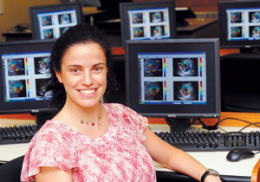Professor Elisa Konofagou, pictured with her work on myocardial elastography, is now leading her team in discovering ultrasound's full potential in fighting disease. Image credit: Eileen Barroso/Columbia University
(PhysOrg.com) -- Biomedical engineer Elisa Konofagou and her team are on the brink of uncovering a new, potentially groundbreaking use for ultrasound: the ability to temporarily open up the natural barrier that separates blood vessels from brain tissue in mice. If the technique works in humans, she says, doctors could use ultrasound to deliver intravenous drugs directly into the brain cells of patients suffering from diseases such as Alzheimer’s and Parkinson’s.
Ultrasound, a reverberating pitch too high for the human ear to recognize, has many applications. It can relax the muscles of aching athletes, melt the fat of liposuction patients and remove grime from kitchen utensils. One of its best-known functions is creating images of fetuses in the womb.
Over the last decade, one Columbia professor has been a leader in unleashing ultrasound’s full potential in fighting disease. Biomedical engineer Elisa Konofagou and her team are using the technology to burn away breast cancer cells, assess the health of a heart, determine the size of an aneurysm and measure the amount of plaque buildup inside an artery.
Now, Konofagou is on the brink of uncovering a new, potentially groundbreaking use for ultrasound: the ability to temporarily open up the natural barrier that separates blood vessels from brain tissue in mice. If the technique works in humans, she says, doctors could use ultrasound to deliver intravenous drugs directly into the brain cells of patients suffering from diseases such as Alzheimer’s and Parkinson’s.
There still is no cure for Alzheimer’s, despite the development of drugs proven to sustain neurons killed by the disease. The reason: a wall-like mass of protein netting, commonly called the blood-brain barrier, that exists to protect brain cells from blood-surfing pathogens. Some researchers have made attempts to slow down the disease by injecting drugs directly into the area of the brain affected. But that procedure is risky, costly and fails nine out of 10 times, says Konofagou.
“Neurodegenerative diseases are undertreated because of the blood-brain barrier,” says Konofagou, whose research is supported by the National Institutes of Health. “Certain treatments can slow down the symptoms, but the impairment of memory and cognitive ability is still jeopardized, and there are huge side effects.”
Her research opens up new possibilities for treatment using a two-step process: Microscopic bubbles would be injected into the blood vessels of patients through an IV line, and then travel into the brain capillaries. Then an ultrasonic beam would be positioned above the hippocampus—which controls memory and is typically affected by early Alzheimer’s—causing the bubbles to oscillate against the blood-brain barrier, temporarily opening it up for drug delivery.
“The blood-brain barrier is like a brick wall reinforced by wires, and this method is a way of temporarily relaxing those wires,” says Konofagou, who holds a joint appointment with the engineering school and the medical school’s department of radiology. She has produced more than a dozen papers on her methodology during the last several months.
“Dr. Konofagou has established herself as one of the leading scholars in neuro-therapeutic drug delivery via the brain-blood barrier, which is currently not possible and would be of great importance in development of viable brain therapies,” says Dr. Peter A. Lewin, director of the Biomedical Ultrasound Research and Education Center at Drexel University, in Philadelphia.
With recent research showing that the early onset of Alzheimer’s disease is detectable in spinal fluid, Konofagou’s breakthrough is particularly timely. In the future, she says, it ’s possible that Alzheimer’s patients could make one hour-long visit to an outpatient clinic every three weeks. Konofagou is quick to note that her methodology has yet to be tested on large animals, and it is a decade away from being used on humans.
Despite its myriad applications, there are some things ultrasound can’t do.
“It can’t provide an image of an entire brain like an MRI, and it can’t do lungs, because it doesn’t penetrate air,” says Konofagou. “But otherwise, I believe ultrasound can do anything.”
Provided by Columbia University






















